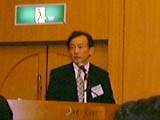![]()
| S-9-14 Role of CD44 and proteoglycan in inflammatory processes: in the context of cell adhesion |
| Y. Tanaka The First Department of Internal Medicine, School of Medicine, University of Occupational and Environmental Health, Japan, Kitakyushu 807-8555, Japan |

![]()
Multiple physiological and pathological processes as well as tissue architecture in multicellular organisms is maintained or regulated by adhesive interactions between cell-cell and cell-underlying extracellular matrix. The relevance of interaction of cells with proteoglycans (PGs) in matrix or on cell surface to cell signaling has been recently emerging. We here document that PGs is involved in cell signaling, shedding light upon inflammatory processes in rheumatoid arthritis (RA).
RA is a representative model of a persistent inflammatory process characterized by marked infiltration of the synovium by T cells. Chemokines produced in large amounts from inflamed tissues trigger integrin-mediated adhesion of T cells to endothelial cells, which results in T cell accumulation in the tissues. Endothelial cells in RA synovium characteristically express heparan sulfate proteoglycan (HS-PG), some of which is CD44v3. HS-PG on endothelium is involved in T cell integrin-triggering by "posting" chemokines and by "relaying" them to their receptors on T cells without being washed away by blood flow, which leads to efficient migration of T cells.
RA synovitis is an extreme characteristic comprised of two diverse phenomena of RA synovial cells, intractable proliferation and growth arrest of the cells, and the mechanisms altering its balance lead to the pathogenesis of RA. Hyaluronan (HA) is the major extracellular PG found in matrix of RA synovium. RA synovial cells highly express CD44, a major receptor for HA. Engagement of CD44 by HA augments Fas as well as VCAM-1 on the cells, and CD44-mediated signaling is involved in adhesion of synovial cells with T cells via VLA-4/VCAM-1 and subsequent interaction of Fas/Fas-L pathway, resulting in synovial cell apoptosis.
We thereby propose that PG is involved in signaling indirectly or directly; cell surface PG is involved in signaling to induce adhesion and migration of T cells by binding chemokines; interaction with matrix PG transduces signals to augment VCAM-1 and Fas on cell surface, which leads to apoptosis of synovial cells. Thus, the role of PG is most relevant to inflammatory processes such as rheumatoid synovitis.
![]()